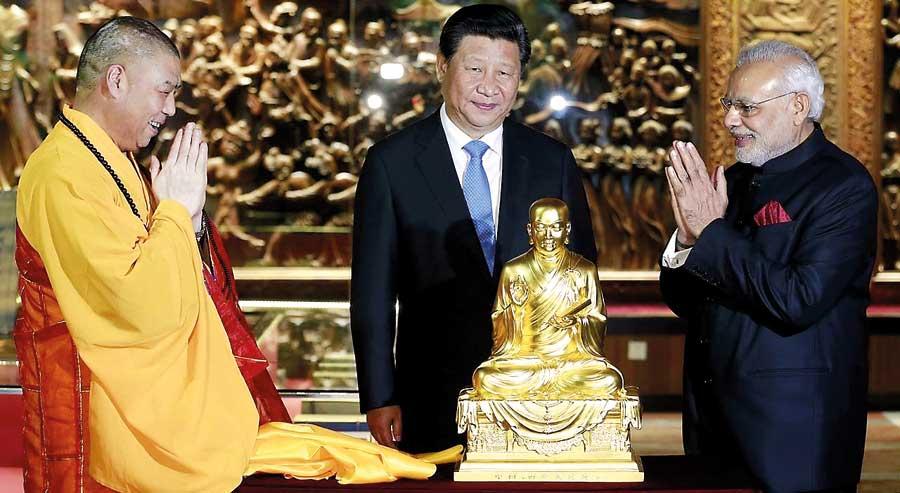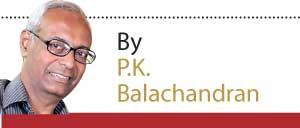Reply To:
Name - Reply Comment

Modi and Xi with a Chinese Buddhist Monk
When the Chinese Ambassador to Sri Lanka, Qi Zhenhong, visited the Tamil majority Northern Province in mid-December, he did things no envoy of Communist China had done before. Ambassador Qi performed puja at the Nallur Kandaswamy temple in the traditional Tamil way, bare-chested, unshod, wearing a white silk vetti and carrying a basket of ritual offerings. The Ambassador did it “with full respect to the Hindu religious and cultural tradition,” the embassy tweeted.
Ambassador Qi performed puja at the Nallur Kandaswamy temple in the traditional Tamil way, bare-chested, unshod, wearing a white silk vetti and carrying a basket of ritual offerings. The Ambassador did it “with full respect to the Hindu religious and cultural tradition,” the embassy tweeted.
The Ambassador’s action is generally seen as a political one, meant to woo the minority Tamils who Beijing had neglected in accordance with its policy of not taking sides in domestic issues.
His mission was also meant to send a message to New Delhi that it cannot claim a monopoly over the Tamils on account of their cultural and linguistic links with Tamil Nadu.
However, Ambassador Qi’s act reflected the emergence of a new-look Communist China where religion is becoming kosher.
"The Ambassador’s action is generally seen as a political one, meant to woo the minority Tamils who Beijing had neglected in accordance with its policy of not taking sides in domestic issues."
A fanatically anti-religious Communist China began changing gradually after Chairman Mao’s death in 1976. Article 36 of the Chinese constitution says that citizens “enjoy the freedom of religious belief.” It bans discrimination based on religion and forbids state organs, public organisations, or individuals from compelling citizens to believe in—or not believe in—any particular faith.
Since February 2018, five years after Xi Jinping took over as President, the Government has been allowing State-registered religious organisations to possess property, publish literature, train and approve clergy, and collect donations.
According to “Freedom House”, in 2017, there were more than 350 million acknowledged believers in China following a variety of local and foreign-origin religions. According to the World Religion Database, Agnostics are 31.8%; Chinese folk-religionists 30.8%; Buddhists 16.6%; Christians 7.4%; Atheists 6.8%; Ethnic religionists 4.2%; Muslims 1.8%; Daoist 0.4%; Others 0.2%.
Commenting on this, Ian Johnson, a Pulitzer-Prize winning writer says in his 2018 paper entitled: “China’s Religious Awakening After Mao” that “it will be no exaggeration to say that China is undergoing a spiritual revival similar to the Great Awakening in the United States in the 19th century.”
Spiritual Vacuum
Explaining the phenomenon, Johnson says that although China has made rapid economic progress and lifted millions out of poverty “hundreds of millions of Chinese are consumed with doubt about their society and are turning to religion and faith for answers that they do not find in the radically secular world constructed around them. They wonder what more there is to life than materialism and what makes a good life.”
He quotes a Chinese Protestant Pastor as saying: “We thought we were unhappy because we were poor. But now a lot of us aren’t poor anymore, and yet we’re still unhappy. We realise there’s something missing and that’s a spiritual life.”
Ordinary Chinese, who are not members of the still strictly secular Communist Party, say that religion “runs in the blood” of the Chinese, though they avoid trumpeting it.
Root of Religion
For centuries, China was rooted in Buddhism, Daoism, Confucianism and various folk religions. Every village had its temples and gods. Religion and politics were inseparable, so much so, that China was a “politico-religious State” and the Emperor was the “son of heaven”. It was in the temples that the local gentry met and organized social and economic life.
But since religion got closely linked to the State, its politics and corruption, the revolutionary, Sun Yats-sen (who overthrew the Qing dynasty in 1912) began his political career by destroying temples. Temples became secular schools. Johnson says that Sun’s successor, Chiang Kai-shek, launched the “New Life” movement to cleanse China of old ways including “superstitions” like religion. Cadres of his Nationalist Party (KMT) destroyed temples, he adds. When Mao’s Communists took over in 1949, they applied the ‘anti-religion’ doctrine even more vigorously.
However, Buddhism and other native faiths could not be obliterated. After Xi Jinping took over the Presidency in 2013, he coopted religion, especially Buddhism. During a visit to UNESCO in 2013, Xi praised Buddhism, saying it had “contributed mightily” to China after it “indigenized” itself hundreds of years ago. He increased allocations for “intangible cultural heritage” preservation which included religious heritage.
World’s Buddhists from 30 countries gathered at an ancient temple in northwest China’s Shaanxi Province in October 2014 for the World Fellowship of Buddhists’ 27th general conference. The temple houses one of Buddha’s finger bones. Xi is using Buddhist links to strengthen economic ties with Buddhist countries in China’s periphery.
Islam and Tibetan Buddhism
But Islam poses a problem for China. Its predominance in the border region of Xinjiang and the activities of the East Turkistan Movement have resulted in oppressive measures against the Uyghur Muslims like mass incarceration in “re-education centres” according to Western Human Rights organisations. While Buddhism, as such, poses no problem, Tibetan Buddhism is viewed with distrust because, historically, it has been under a separate order headed by the Dalai Lama.
Communist China, which absorbed Tibet in 1950-51, replaced the Dalai Lama-led order with its own. The current Dalai Lama, who fled from Tibet to India in the 1950s, is persona-non-grata in China.
Christianity
In the Colonial era, Christianity had an appeal among the Han Chinese. Chinese reformers viewed Christianity as a progressive doctrine because developed Western nations were Christian. In fact, Chiang Kai-shek, the leader of the Chinese Nationalist Party (KMT), was a convert to Christianity. But among the broad Chinese masses, Christianity was an alien religion as reflected in the saying: “One more Christian; one less Chinese.”
Beijing is wary about Christianity apparently because of its Western links. Western accounts say that between 2014 and 2016, the Government forcibly removed crosses atop more than 1,500 churches in Zhejiang province. Johnson says that this proved to be a precursor to a series of steps against other churches, including three of the best-known Protestant underground churches in China: the Zion church in Beijing, the Ronguili church in Guangzhou and the Early Rain Church in Chengdu.
The Government’s policy on Catholicism, on the other hand, is softer and diplomatic, Johnson points out. In 2018, China and the Vatican agreed to allow the two sides to jointly appoint bishops. Pope Francis recognised seven bishops appointed by China. BBC said that the issue of who could appoint bishops had been at the heart of a dispute since China first broke off diplomatic ties with the Holy See in 1951.
Sinicization and Limits
Be that as it may, it is pointed out that Churches and Christian pilgrimage sites are surveyed by closed-circuit television cameras, as is the case in Mosques. Buddhist or Daoist temples are not monitored as they are considered indigenous Chinese religions. But all religions have to “Sinicize” themselves which, in effect, means following the dictates of the Communist Party and the Government on the question of culture and nationalism.
Though religions have huge and growing followings in China now, they are not allowed to dictate policies to the Government. Religions would have to follow the prescriptions of the Chinese State as dictated by the Communist party.
According to Johnson, what President Xi is doing is to recreate the old politico-religious state that was China in the past. But the difference is that, now, religion is clearly subordinate to the political apparatus.
In the public sphere, religion functions as a tool in the hands of the government pursuing its political, social and ideological agenda.
Irrespective of what China says, the Western view of the State of religion in that country is that Xi Jinping, like Vladimir Putin in Russia, is using religion to “legitimize authoritarian rule.”
Western commentators do not acknowledge that China has come a long way from religious intolerance to allowing believers to express their beliefs. As in other spheres, popular and scholarly views on this matter get coloured by geopolitical considerations.